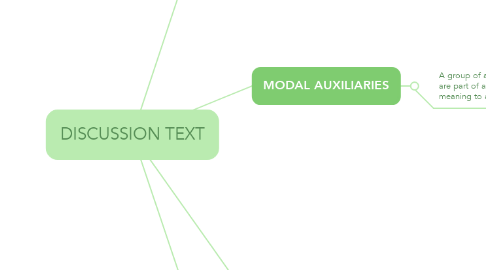
1. SIMPLE PRESENT TENSE
1.1. DEFINITION
1.1.1. Is a form of verb to express facts, habits, or events that occur at this time.
1.2. PATTERN
1.2.1. POSITIVE (+)
1.2.1.1. S + Verb (1) / Verb dasar / to be (is, am, are) + O
1.2.2. NEGATIVE (-)
1.2.2.1. S + Don’t / Doesn’t + Verb (1) + O or S + (is, am, are) + not + O
1.2.3. INTERROGATIVE (?)
1.2.3.1. Do / Does + S + Verb 1 + O
1.3. EXAMPLE
1.3.1. POSITIVE (+)
1.3.1.1. She reads Harry Potter books every day
1.3.2. NEGATIVE (-)
1.3.2.1. She doesn’t read Harry Potter books every day
1.3.3. INTERROGATIVE (?)
1.3.3.1. Does she read Harry Potter books every day?
2. CONJUNCTION OF CONTRAST
2.1. ADDITIONAL INFORMATION
2.1.1. Moreover, besides, in addition, also, furthermore
2.2. TIME
2.2.1. While, When, After, Before, Etc
2.2.1.1. Example : I decided to go after it stopped raining
3. MODAL AUXILIARIES
3.1. A group of auxiliary words that are part of an auxiliary that add meaning to a sentence.
3.1.1. Rules of use “Modal Auxiliaries”
3.1.1.1. The verb cannot be added with –s / es if there is a modal auxiliary.
3.1.1.1.1. Example : He can makes a fruit cake ❎
3.1.1.1.2. He can make a fruit cake ✅
3.1.1.2. The auxiliary modal between the verb cannot be connected with "to"
3.1.1.2.1. Example : They can to take this paper to that room ❎
3.1.1.2.2. They can take this paper to that room ✅
3.1.1.3. Modal auxiliary past tense, the verb to be used must be the (infinitive).
3.1.1.3.1. Example : They could sang at the karaoke until midnight ❎
3.1.1.3.2. They could sing at the karaoke until midnight ✅
3.1.1.4. An (interrogative sentence) is formed by placing a modal auxiliary in front of the sentence.
3.1.1.4.1. Example : Can your father speak English well?
3.1.1.5. A denying sentence (negative sentence) is formed by adding a note after the modal auxiliary.
3.1.1.5.1. Example : Would, must, can, need, could, should. in contraction form wouldn’t, mustn’t, can’t, needn’t, couldn’t, shouldn’t
4. NOUN PHRASE
4.1. DEFINITION
4.1.1. Is a phrase that is the result of combining a noun, pronoun, or number.
4.2. PATTERN OF NOUN PHRASE
4.2.1. 1. Noun + Noun
4.2.1.1. Example : The “bohemian house” was brightly decorated for the holidays.
4.2.2. 2. Noun + Of + Noun
4.2.2.1. Example : Some people say Jakarta is the “city of angles”
4.2.3. 3. Determiner + adverb + adjective + noun
4.2.3.1. Example : Pajero Sport is “a really nice car”
4.2.4. 4. V-ing + Noun (as Gerund)
4.2.4.1. Example : Snowbay is a “swimming pool” located in TMII
4.2.5. 5. V-ing + Noun (as Participle)
4.2.5.1. Example : He is a “smoking man”
4.2.6. 6. V3 + Noun (as Participle)
4.2.6.1. Example : At the zoo, I saw a “striped” Zebra

